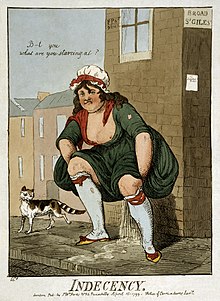Isaac Cruikshank
| Isaac Cruikshank | |
|---|---|

Indecency, among Cruikshank's most notable works. Published in London by S.W. Fores, 1799
|
|
| Born | 1764 Edinburgh, Scotland |
| Died | 1811 London |
| Cause of death | alcohol poisoning |
| Nationality | Scot |
| Occupation | artist, caricaturist |
| Spouse(s) | Mary MacNaughton (1769–1853) |
| Children |
Isaac Robert Cruikshank (1789–1856) Margaret Eliza (1808–1825) Mary (1795–1795) |
| Parent(s) | Elizabeth Davidson (born c.1725) Andrew Crookshanks (c.1725–c.1783) |
Isaac Robert Cruikshank (1789–1856)
Isaac Cruikshank (1764–1811), Scottish painter and caricaturist, was born in Edinburgh and had most of his career in London. Cruikshank is known for his social and political satire. His sons Isaac Robert Cruikshank (1789–1856) and George Cruikshank (1792–1878) also became artists, and the latter in particular achieved fame as an illustrator and caricaturist.
Isaac Cruikshank was born in 1764 to Elizabeth Davidson (born c.1725), daughter of a gardener, and Andrew Crookshanks (c.1725–c.1783), a former customs inspector, dispossessed for his role in the Jacobite uprising of 1745. Isaac grew up in New North Kirk parish in Edinburgh after his family moved there. He was the youngest child, and was interested in all sorts of hobbies including sports and music. Isaac studied with a local artist, possibly John Kay (1742–1826).
In 1783 Cruikshank left Scotland to travel to London with his master. There he married Mary MacNaughton (1769–1853) on 14 August 1788. The couple had five known children, two of whom died in infancy. A daughter, Margaret Eliza (1808–1825), a promising artist, died at the age of eighteen of tuberculosis. Their sons Isaac Robert Cruikshank (1789–1856) and George Cruikshank (1792–1878) also became artists.
Cruikshank's first known publications were etchings of Edinburgh "types", from 1784. His first caricature etching called Scotch Eloquence was of Edinburgh characters. He produced illustrations for books about the theatre, did the frontispiece for Witticisms and Jests of Dr Johnson (1791), and illustrated George Shaw's extensive General Zoology (1800–26). His water colours were exhibited, but in order to make a living, he found it more lucrative to produce prints and caricatures. He was responsive to the marketplace but firm in his dislikes of Napoleon and Britain's home grown political radicals, including, for example, the members of the London Corresponding Society and the Society of the Friends of the People He and James Gillray developed the figure of John Bull, the nationalistic representation of a solid British yeoman. His Olympic games or John Bull introducing his new ambassador to the grand consul (1803) and Boney at Brussells (also 1803) contrast an implied European capitulation and British defiance under the threat of invasion.
...
Wikipedia
